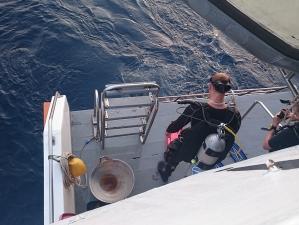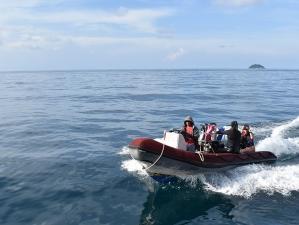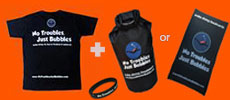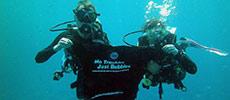There’s so much to consider when choosing your next scuba diving liveaboard safari. Some things may be fixed or limited, such as budget & dates. But even within these limitations, there are so many other things to think about. This blog helps you compare liveaboard scuba diving around the world. All 16 questions below are answered in detail on this page. This blog is long, but you can easily just skip to which sections are most interesting or relevant.
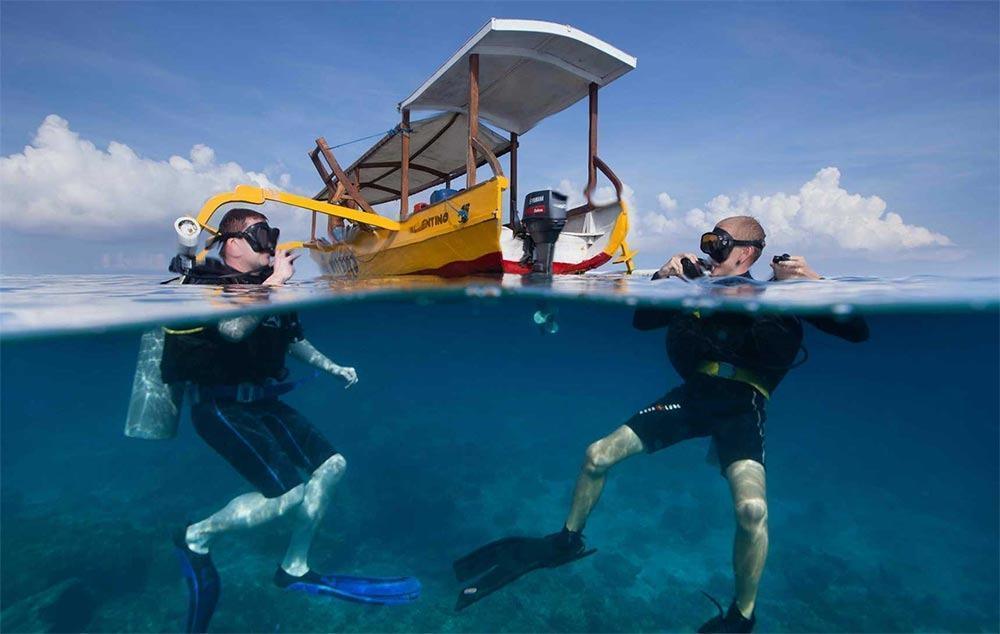
So, to find out all you need to know, just keep reading. Or skip to the sections or questions you’re most interested in, by clicking on the list above.
1 Best Liveaboard Diving Locations
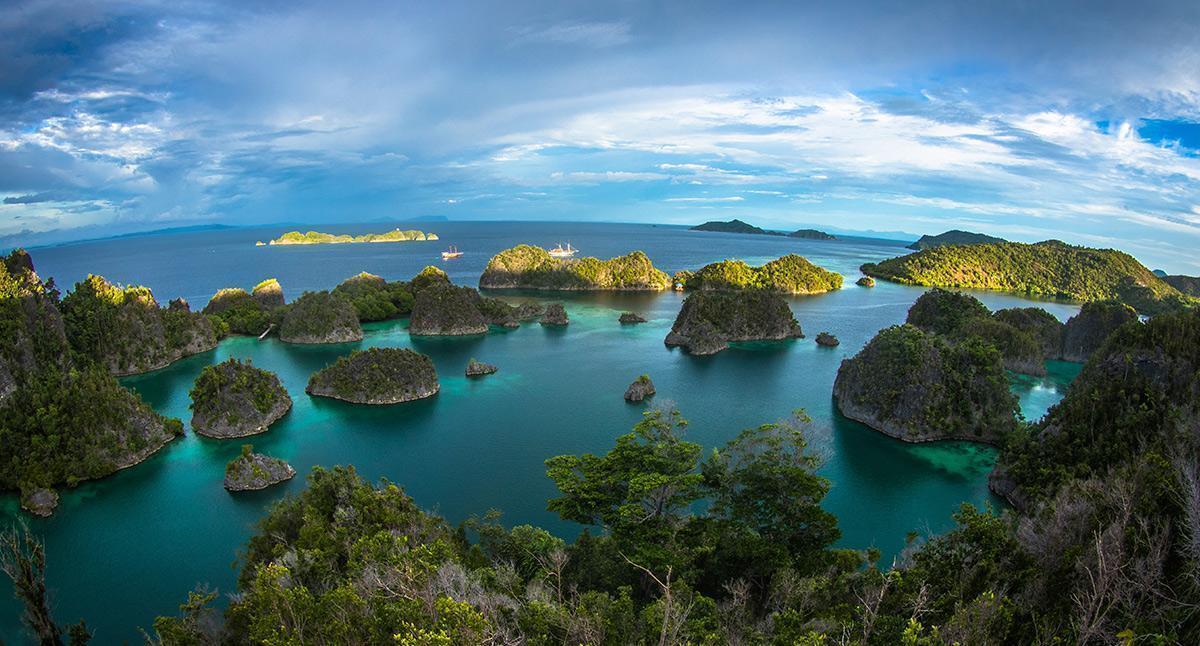
Scuba diving liveaboard cruises are available all around the world, especially in tropical and sub-tropical zones. Not only are colourful corals & reef life much more abundant in warmer water, but diving up to four times a day isn’t much fun in the cold. Liveaboard diving is popular in The Indian Ocean, The Red Sea, The Caribbean, Galapagos, and the South Pacific. Of course, depending on where you’re based some of these areas are easier to get to than others. It’s often a balance choosing between places that are more accessible with somewhere remote & exciting. In general, less-developed areas have more pristine marine eco systems.
Tropical & sub-tropical regions, normally have three seasons each year, not four. So, you can expect year-round warm temperatures, but usually a high season, a monsoon season, and something in between.
Scuba diving in places like The Red Sea, The Maldives, Indonesia and The Caribbean is possible all year round. Their ‘low seasons’ may have slightly cooler weather, stronger winds at times, and some rain, but excellent diving cruises can still be enjoyed. South-East Asia has several countries ideal for scuba diving liveaboards, most notably, Indonesia, Thailand and Myanmar. It’s possible to join a diving liveaboard in The Philippines and Malaysia, but not nearly as common or as popular.
So, depending on where you’re coming from and how far you plan to travel, your starting point for choosing the best liveaboard diving vacation is ‘which region or country.’ Within the sub tropics you can expect warm clear water and plenty of marine life. Diving in just a wetsuit, or sometimes without even that, you can enjoy dives of up to an hour or more without feeling cold. Then, between your dives you can chill out on board enjoying the sea breeze & views.
Our top destinations are Egypt (best value), Maldives (best marine life), Thailand (best choice of itineraries), and Indonesia (best natural diversity). But other places are very special as well. Myanmar is mostly undiscovered, but not so far away. The South Pacific offers unique opportunities to dive with migrating whales. And Central America has something for everyone, and let’s not forget Galapagos!
But before you get carried away, it’s important to know how much this is likely to cost you. Our next two sections discuss the prices, and how to get the best deal.
2 How Much Does Liveaboard Diving Cost?
Before you look at the prices and think ‘Hey, that’s more than I budgeted for!’ don’t forget that liveaboard diving rates include your accommodation & meals. All include unlimited drinking water, coffee, tea, fruits & snacks, and many include soft drinks as well. Plus of course the price includes diving up to four times per day, usually with a professional guide, and the use of tanks & weights. So, how do you calculate the cost & compare liveaboard diving in different countries? There are many variables, such as the length of the trip and how many dives you get. Plus your chosen cabin will affect the price that you pay.
If you try to compare prices on a ‘cost-per-day basis’ you have to be very careful not to be misled. Several liveaboard diving websites show a price per day for each boat or area, but they count & include non-diving days and ‘half days’ in order to make the rates look cheaper. For example, a trip that starts on a Saturday evening and ends the following Saturday early in the morning should really be shown as seven nights & six diving days. But other websites will advertise it as 8D/7N (eight days & seven nights), and divide the cost of the trip by eight to get a daily rate. This is more than misleading, it’s cheating. So, how should you calculate the cost? Keep reading to find out.
Another way to calculate & compare liveaboard prices is on a ‘cost-per-dive basis.’ You simply divide the cost of the trip by the number of planned dives. Although this method is better than ‘per day’, you need to remember that itineraries are prone to change due to weather or sea conditions, or you might decide to skip a dive for any reason.
And finally, nearly every boat has a choice of cabins at different prices. Most boats’ cabins are for two guests, and priced ‘per person’ but many boats have single cabins, triple bed, four bunk and one or two boats even have cabins that can accommodate up to six guests!
So as you can see, there’s no clear answer to this question. But to give you an idea of cost, expect to pay at least $100 USD / €100 per person for each day on board. This includes accommodation, meals and the scuba diving. This price is the lowest that you can expect to pay, and can be as much as $500 / €500 per day for the best cabin on a luxurious boat that sails far out to sea. In general $180-250 / €180-250 is an average daily rate for a very comfortable experience. And if you want to know how any discounting works for scuba diving liveaboard safaris, then just scroll down to the next section where we discuss how to get the best deal.
3 Getting the Best Deal
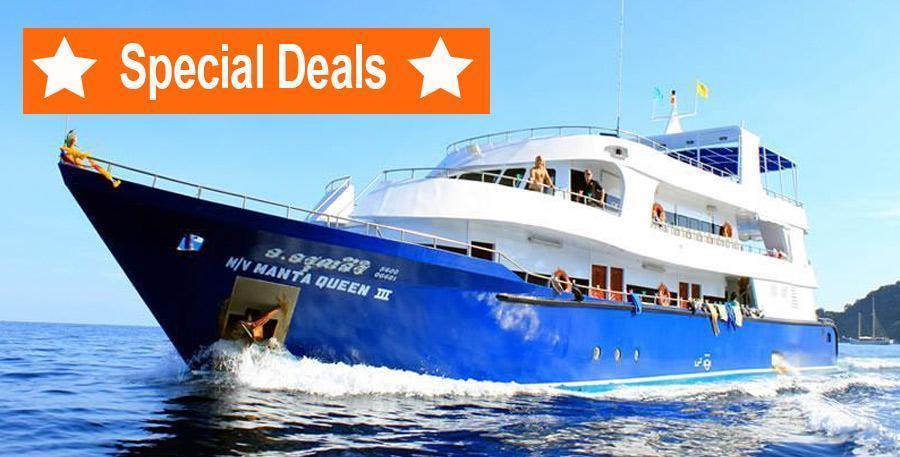
We all like a bargain, and no one wants to pay more than others pay or more than necessary. Getting the best deal when booking a diving holiday helps you to enjoy it even more! You’d be surprised to know that quite a few liveaboard boats around the world don’t offer any discount or special deals at all, ever! But the majority of boats do have some special deals from time to time. This might be offering something for free, such as Nitrox, gear, or a cabin upgrade, but it’s usually a discount of 10-20% off of the trip price.
Early Bird Discounts
Early Bird Discounts are very common for people who want to book a trip several months or more than a year in advance. Sometimes you can get a discount and free gear or Nitrox, but just a 10-15% discount is most common. Not all early-bird deals are available for the most-popular trip dates, such as Christmas & New Year, but some are. You usually have to pay the whole trip price several months before departure to get the Early-Bird Discount, but a few boats allow their regular booking & payment terms as well as the discount.
Last Minute Discounts
Last Minute Discounts are available on many boats when there are still some unsold spaces left. The boat operators want to fill the trip up, and getting 80% of the regular price is better than nothing, so they offer (on average) 20% discount. Usually there are limited spaces and cabin types available for the last-minute deals, but it’s often possible to get a great bargain for your next liveaboard diving adventure.
Shopping around for a discount
Shopping around for a discount is not recommended. If you book your trip directly through the operator or through an agent, the price is the same. Boat operators forbid agents from undercutting them on the price, and in turn they will not undercut the agents. This way there isn’t a price war that would result in a drop in service, quality and safety. Also, it enables you to choose the best service.
Now keep reading to find out what you can expect to see & experience underwater on a liveaboard cruise.
4 Life Underwater on a Liveaboard Diving Safari
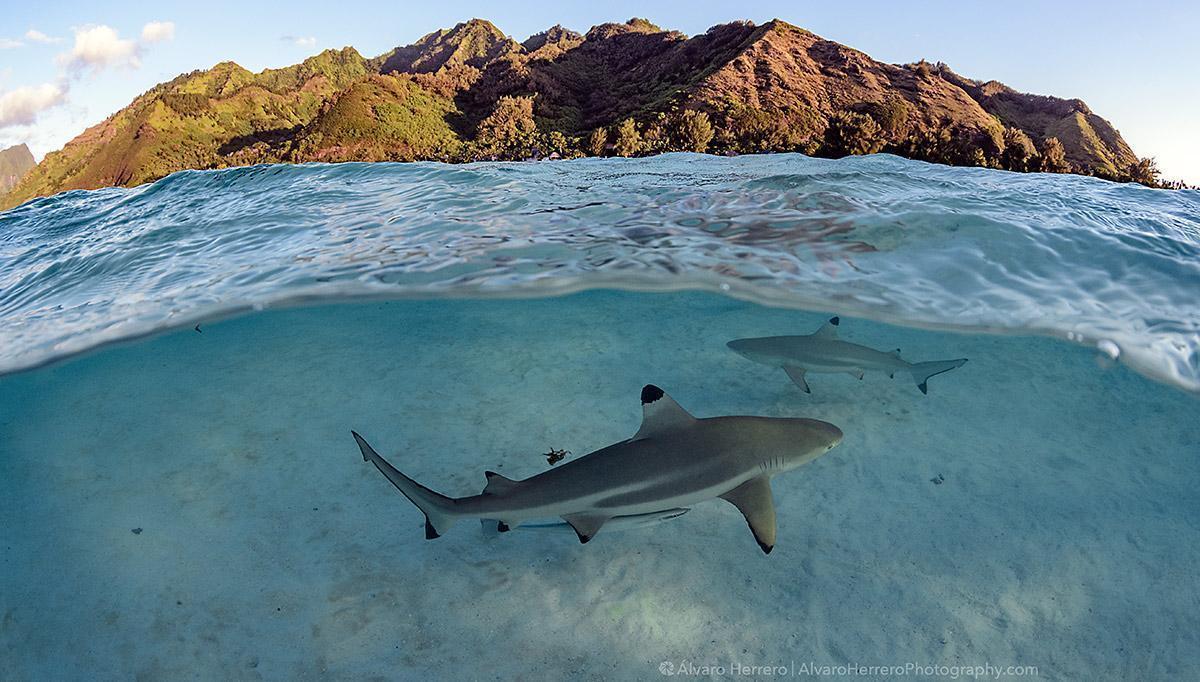
Nothing is guaranteed, except that you will get wet! Don’t forget that scuba diving is dealing with Mother Nature, in the hope of seeing the best of Mother Nature. Weather & sea conditions can be better predicted now than in the past, but surprises (good & bad) are always possible. Shipwrecks & coral reefs don’t tend to move, but the water and all the marine life does. And that’s what makes every dive special because you can never be sure what you will see.
On most liveaboard trips you can dive up to four times per day. Normally trips are planned to make the most of the conditions, for example sailing during months when the weather’s best. Dive timings should follow a bit of a plan, like jumping in at the slackest tide, and ensuring time at the surface to off gas. They also try to dive when conditions are best, but there may be times when you have to face a current or deal with some surface waves. As for visibility, this is 100% up to Mother Nature, but sensible predictions can be made in each area.
Your trip leader will brief you on what to look out for and which species are normally seen at each location. Only in some cases can they guarantee the sighting of a particular fish or invertebrate. But let them know what you like, or what you’re not interested in being shown. And make sure that you understand the hand signals for commonly-seen species, so that you don’t get confused about what you’re being shown.
Sharks are most divers’ friends, so seeing one is usually a bonus. Other large species that are popular & exciting include Manta Rays & dolphins. Each diving destination has its special species and the commonly-seen ones.
When scuba diving make sure that you
- always dive within your limits
- respect nature & every living thing in the sea
- tell your dive guide what you’re interested in
- leave only bubbles
- take only memories, or pictures & video!
Do you get seasick? Don’t be ashamed, because it can affect anyone. In general, liveaboards are large & sturdy enough to handle any waves that they expect to come across. And all the boats have pills on board that are usually available for free. But remember to take a pill before things get bumpy, because they don’t make you feel better after you start feeling bad. They prevent the problem before it begins, not after.
In the next section you can read about how to get to your chosen destination, as well as how the liveaboard teams normally meet you and take you to the boat.
5 Getting There
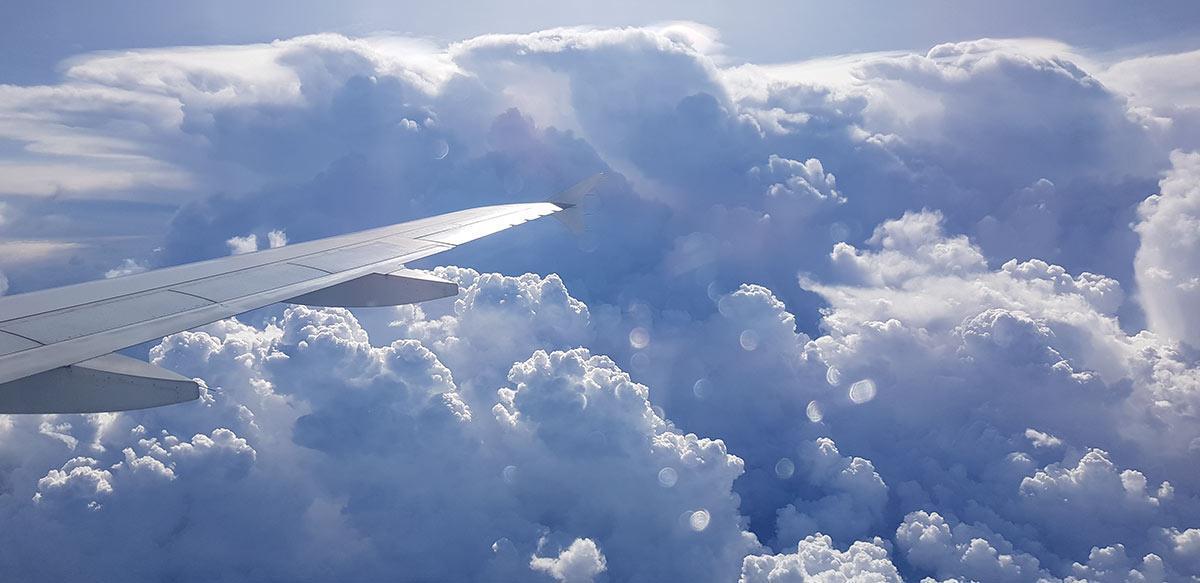
Some of us enjoy travelling to a liveaboard boat to start a cruise, while others just want to get there as quickly as possible. Maybe your journey is short, or maybe you have to travel around the world to go diving.
Nearly all liveaboard operators will collect you and take you to the pier or harbour where you can board the boat. And transfer you back after the trip. But it’s important to remember that there’s a limit to how far they can travel, and the transfer times fit in with the itinerary more than the guests’ convenience.
International & domestic flights
International & domestic flights are almost never included in the price of your liveaboard trip. In some cases, such as liveaboard diving in The Maldives when the boat departs from or returns to an atoll in the far north or south, a domestic flight might be included in the price. But this is only in rare cases. It’s your responsibility to arrange flights so that you arrive in time, and don’t fly within 24 hours of the final dive of your trip. One of the biggest and best websites for booking flights and hotels is Kayak, which has a great reputation for price and choice.
Visas
Visas are almost never included. So you need to check if your nationality requires a visa to enter the country or not. Also, make sure that your passport is valid for at least six months from when you arrive.
Road transfers from local hotels & airports
Road transfers from local hotels & airports are nearly always included in the free transfers. The liveaboard operators may hire a local taxi company to collect guests, or they may have their own team of drivers and vehicles. It all depends on each situation, and can even vary for each boat & trip.
Pickup times
Pickup times are planned to fit in with the boat, not for your personal convenience. Ok, so they don’t go out of their way to make things inconvenient for you, but they also don’t consider what time you might want to wake up, have breakfast & check out of a hotel. The road transfers are planned so that you arrive on the boat with time to do a final check that you have everything and it works & fits before sailing. But in most cases the boat is being prepared on departure day, so the staff and crew are busy and there’s a lot going on. Guests arriving too early get in the way, and those who arrive too late might delay departure.
Shared transfers
Shared transfers save the cost of fuel, vehicles & drivers. In most cases you will be in a minivan or similar vehicle with other guests on your trip. This is another reason why the pickup times are set. It’s all planned to collect guests furthest away first, then those nearest last. Or if from the airport, they might ask anyone on an earlier flight to wait for other guests who land a bit later.
Local hotels & airports
Local hotels & airports are the most-common pickup locations. Sometimes, a diving liveaboard operator might offer transfers of several hours from an airport that’s not the nearest, but you need to check first. For example, liveaboards in Egypt’s Red Sea often change their departure and return harbours, sometimes at the last minute. So if you were planning to fly into or out of Hurghada for instance, and the boat uses Marsa Alam or Port Ghalib, the three-hour-long road transfer might be included. But don’t just presume this. Check first!
Our next section explains & compares the different types of liveaboard diving itinerary. They can vary greatly within a country or destination, but there are also many similarities around the world. Keep reading to find out more about the trips, and start to get excited about your liveaboard!
6 Trip Lengths & Different Itineraries
Now things are getting more interesting. In this section you can read about how liveaboard itineraries compare around the world. By definition, a liveaboard trip needs to be at least two days & one night in length. Anything shorter is a day trip. Short liveaboard diving trips are possible in some countries, but in most cases you’re looking at four days & nights, and often a whole week on board.
‘How long is a typical liveaboard diving safari?’ is not a simple question to answer. Some boats have fixed trip lengths, for example one week or four days & nights. Others offer different trip lengths depending on the planned dive sites, time of year, or if the boat needs to get from one part of a country to another. There really is no fixed answer, but keep reading to learn about trip lengths, and how the itineraries are planned to maximise the fun and minimise cost & inconvenience to you.
Short liveaboard trips
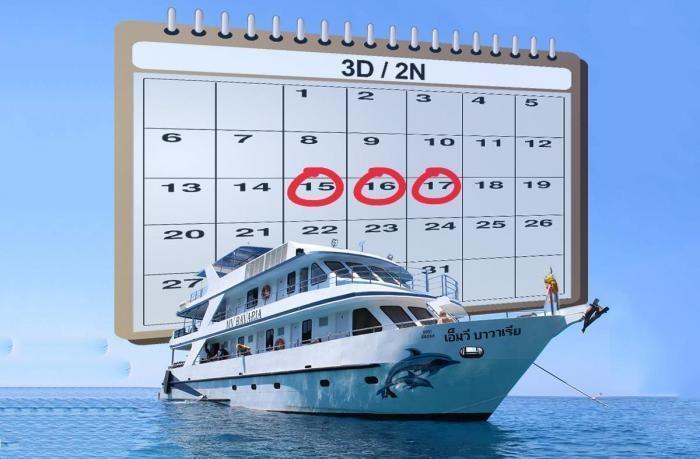
Short liveaboard trips are usually just one or two nights in length, giving you two or three days’ diving. These nearly always involve you leaving in the morning, often on a speedboat out to the main liveaboard that’s already at sea. It doesn’t always work this way, but usually. Overnight and 3D/2N trips are ideal for people who don’t want to commit to sleeping on a boat for too long, or those on a budget. Normally, you get two or three dives on the first and last day of the trip, and if it’s a 3D/2N trip you can get four dives on the middle day. These trips are available in countries around the world, but not at all of our dive destinations.
Medium-length liveaboards
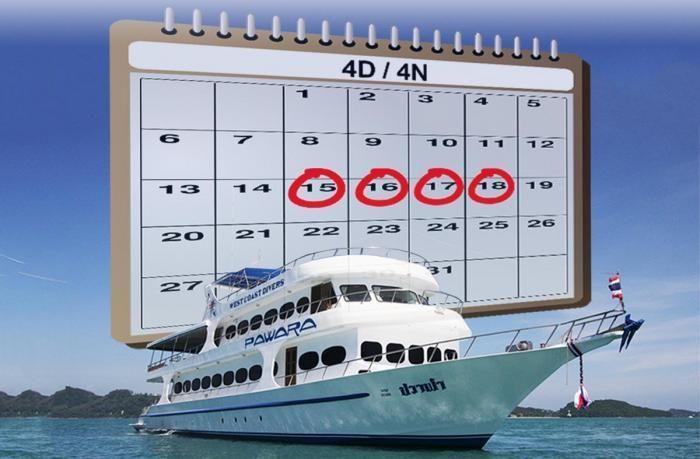
Medium-length liveaboards are often four days & nights (4D/4N). For these, you usually board the boat in the evening and the boat sails through the night. Then you dive up to four times each day for three days, and on the final day you get two or three dives and disembark in the afternoon. These types of trips are very common at The Similan Islands in Thailand. Four days & nights is plenty of time to enjoy lots of dives without missing the mainland and its creature comforts. But the disadvantage of diving in the morning and then leaving the boat the same day is that you can’t fly until the following day, meaning you will need to stay in a hotel that night. Most Similan liveaboards sail from Khao Lak, so it makes sense to discover more things to do in Khao Lak either before or after your diving safari.
Week-long dive cruises
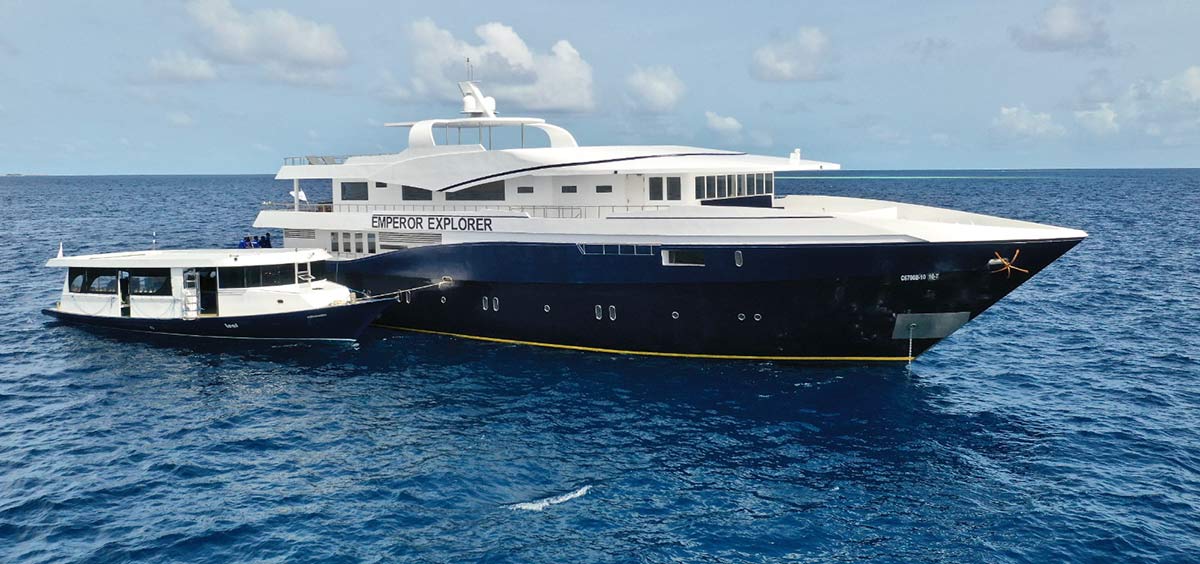
Standard week-long dive cruises are the norm in places like The Maldives, Egypt & around some parts of Central America. They’re ideal for people who have a week off of work to enjoy a diving vacation. You can fly in, board the boat, dive, get off the boat, & fly home. If you’re wondering how this is possible with the logistics and no-fly time, here’s how.
- You land at the nearest airport to where the boat departs from, and the team will come to meet you. This is explained in section 4 above. Flight arrival times are usually from lunchtime until late afternoon and you go straight to the boat without needing to stay in a hotel. Arriving at lunchtime might enable you to get a check dive in on the same day, but maybe you’re too tired or this is not offered. The boat might sail through the night, but in Egypt, the Maldives and some other countries the boat stays in the harbour while you check in, relax, and get a good night’s sleep in your cabin.
- You then get five full days’ diving, sometimes up to four times each day.
- On Day #6 (the final full day of your cruise) you do two dives in the morning. That gives you time to wash & dry your dive gear, and prepare to leave the boat without any need to rush. And all this time your body is expelling excess Nitrogen. The boat sails smoothly back to the harbour.
- After breakfast on your final day (Day #7) you wake up & enjoy breakfast. By the time you have been taken to the airport, checked in and gone through immigration, it’s already 24 hours since your last dive, and you’re good to fly!
Longer liveaboard cruises
Longer liveaboard cruises are usually 10 to 14 days & nights on board! In nearly all cases, these longer trips start in one part of a country and finish in another. For example, Indonesia is so large that there are different high & low seasons. The best time to dive at Raja Ampat is November to April, but the best diving in Komodo is June to September. Boats which offer trips all year round might want to get from one region to another, and there are some awesome diving areas on the way. Don’t feel that you’re just a passenger on a ferry. These ‘crossing trips’ give you chance to dive in some very special places, and you get the best variety of dive sites and marine life. And to show how popular they are, they’re often fully booked a year in advance!
So, now you see that scuba diving liveaboard trips can be as short as two days & one night, or up two weeks long! And we haven’t even discussed the different types of liveaboard boat yet. For that, it’s all in the next section, and you only need to scroll down.
7 Different Types of Diving Liveaboards
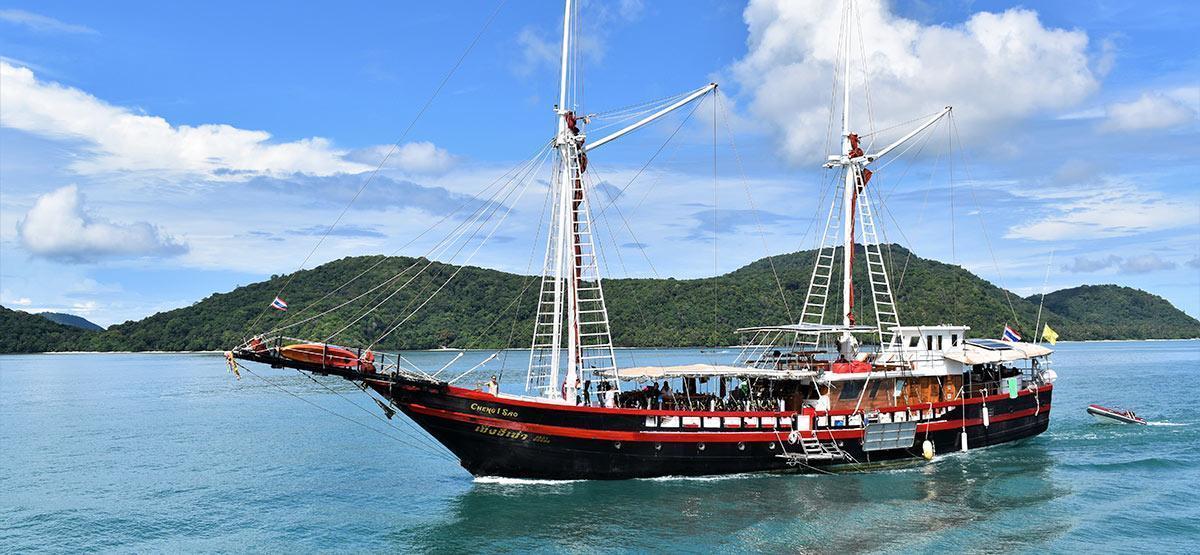
There are quite a few different types of scuba diving liveaboard boat, and the only thing that they all have in common is somewhere for guests to sleep during the trip. Cabin types are also explained in this section, so don’t go away just yet.
A lot of scuba diving liveaboards are purpose built from the start, some are converted fishing boats, and others are yachts that were converted, or purpose-built for diving. Which is best for you depends on your taste. The purpose-built dive boats are more practical and usually newer, but they don’t have the same character as some yachts & schooners. Fishing boats are very easy to convert and keep the practicality for scuba diving.
Purpose-built diving liveaboard boats
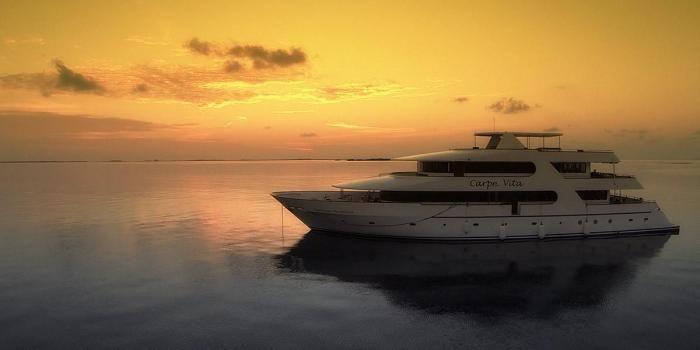
Purpose-built diving liveaboard boats offer the best practicality simply because the boats were designed for the purpose of diving, with guests sleeping in cabins. Everything is in a place to maximise comfort, convenience & practicality. They tend to be 30-40 metres in length, and accommodate 18-30 guests. Guest cabins can be located on the lower, middle or upper decks. They can be constructed of marine-grade steel, or wooden. They usually have a large air-conditioned lounge saloon and indoor dining area.
Traditional schooners

Traditional schooners are attractive wooden boats that have sails, although nearly all spend most of the time propelled by motors. Some began their lives serving another purpose, but many are purpose built for diving, especially Indonesian phinisis. Guest cabins are usually in the lower deck, but not always. Diving is usually done from a tender dinghy because these types of boats don’t have a low dive platform near to the water’s surface.
Converted fishing boats
Using converted fishing boats for diving doesn’t sound very romantic, but you’d be surprised how well it works. The inboard motors are already at the back, and the dive deck is easily made from what was once the area to handle the day’s catch. Guest cabins are easily made on any deck. The boats don’t usually have an air-conditioned lounge saloon, but many people come on a dive trip to enjoy the views & sea breeze. They vary in length from 20-30 metres and are often made of wood.
Other types of boats
Converting other types of boats for scuba diving liveaboard trips is also quite common, and includes all kinds of designs using wooden or steel hulls.
That’s enough about the boats, for most people the cabin that you sleep in is really important. Guest cabins on diving liveaboards vary in size, design, facilities and how many people they can accommodate. By far, the most common number of guests per cabin is two, either in a double bed for couples or two single beds. But many boats have single cabins, three-bed, four-bed and even six-bed cabins. Don’t forget that prices are ‘per person.’
Air conditioning is pretty-much standard nowadays, but a few boats don’t offer it. In some cases each cabin has its own temperature controller, while others are controlled centrally.
A private bathroom is always nice, and on most boats this is standard, but budget boats may only offer shared bathrooms.
Storage space for your personal belongings is necessary, but don’t forget that space on boats is always at a premium. Pack as little as you need for your liveaboard trip.
Windows usually come in the form of small portholes on lower decks and standard windows on higher decks.
Finally, AV entertainment such as a television is regarded as a luxury for inside cabins, and therefore not normally found on the budget boats or those which offer shorter trips.
As for communal areas on scuba liveaboard boats, all boats have a sundeck for those who want to top up a tan or gaze at the clear night sky. It’s also necessary to have a covered dining area outside if the boat doesn’t have an indoor dining room. Places to relax and socialise include outdoor decks with seating as well as an air-conditioned lounge saloon. But hey, who comes all this way to enjoy a scuba safari and hide indoors? It’s much nicer to be out on deck with the views & sea breeze.
Our next section discusses how the diving is organised into groups, who leads the dives, and if support vessels are used for the beginning & end of each dive.
8 Who Dives with Who, & How?
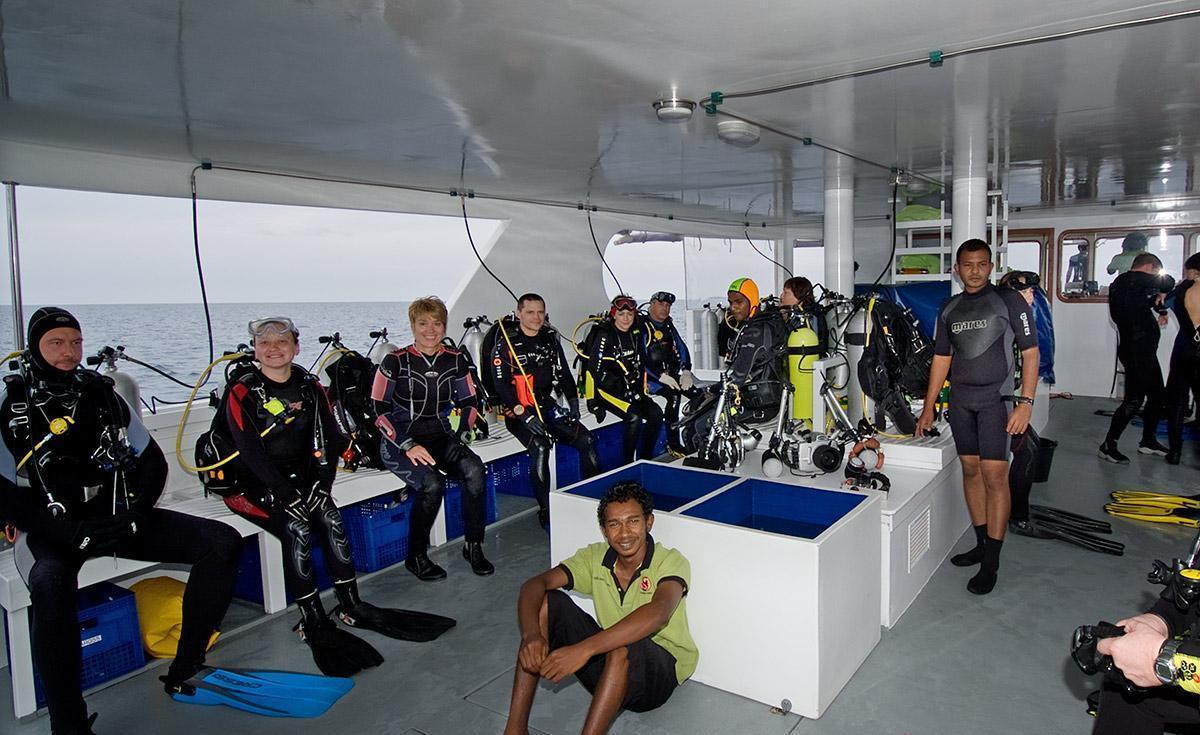
So now we know about how to get there, what the boats are like, what we might see in the water, the itineraries, and how much it costs, but how about who you will dive with? Couples, families & friends will want to dive together, and this is normal unless their certification levels & experience differ greatly. Solo divers are normally placed in a buddy group with other guests.
Unguided diving

Unguided diving is when you dive with your buddy or in a small group without an underwater guide employed by the boat. This is only possible or practical if you are an experienced diver and the dive site is not complex or prone to strong currents. Unguided diving requires a clear dive briefing and everyone to follow the rules & procedures. The dive staff remain on the boat and monitor the situation from there. In some countries unguided diving is not allowed, but in others it’s quite normal.
Guided diving
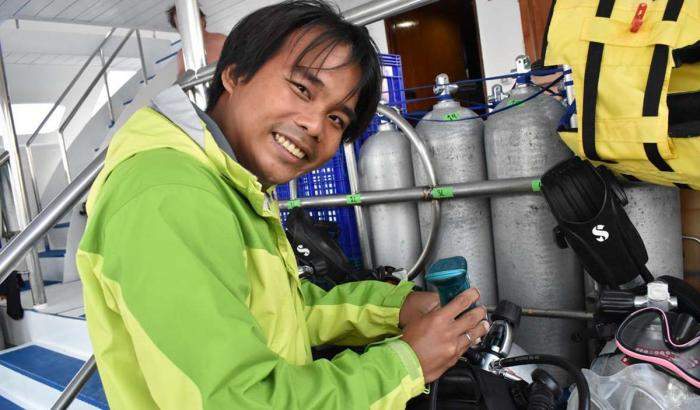
Guided diving is most common on liveaboards. This is when a member of the boat’s dive staff will be your group’s underwater guide. He or she will lead the way, pointing out interesting marine life, and manage the depth & time depending on the group’s air consumption and any other factors. Four guests per guide is the average number in a group, but this can be more or less. In some cases the dive guide might send a buddy pair up to the surface early, or take them up and leave a buddy pair on the reef. This mainly depends on any differences in air consumption levels. Safety always comes first!
Local dive guides
Local dive guides may not have travelled the world very much, and they may not have excellent language skills or understand your culture or jokes. But local guides are often the best underwater. They seem to have this ability to spot the cool stuff and they know where to find some special species on the reef.
International dive guides
International dive guides are very popular because they have normally travelled the world and dived in many different & special destinations. And they may even speak your language or come from the same country as you. This makes many things so much easier on the boat, including helping out with small problems and socialising or sharing jokes.
Different types of liveaboards have their own ways of divers getting into and out of the water. Some divers are adaptable to all ways, but maybe you prefer one way and don’t like another. Read on to understand the three main ways you can start & end a dive on a liveaboard safari.
Diving from the main boat
Diving from the main boat seems the obvious way, and in most cases this is how it’s done. You gear up and take a few steps from your tank slot and wait at the back of the boat, where the dive platform is very near the water level. Ideally the liveaboard can move in above the dive site and in groups the divers jump in. At the end of the dive, you can swim to the back of the boat or the crew can throw a buoy on a rope for you to hold. When you are safely on board and have removed your gear, you can go for a shower. In an ideal world, this is the way to do it. But what if the large liveaboard can’t get right over the dive site? Maybe there’s a current, or it’s crowded with other boats, or local laws forbid it. And what if divers end their dive at the surface, spread out over a wide area?
Using tender dinghies
Using tender dinghies is normal for when large purpose-built liveaboard boats can’t get over the dive site, or divers surface far away. The dinghies can drop you off at the dive site, or pick you up at the end of your dive. And most schooner yachts don’t have a dive platform that is near the surface of the water. In this case, you climb down from the main boat into the dinghy, then put your fins on and roll off the back of the dinghy into the water. Tender dinghies also ensure people get picked up more quickly.
Support vessels
Support vessels are the best balance for many reasons, but they come at a higher cost to the operator. Mostly used in The Maldives, dhonis are diving boats which sail along with the main liveaboard. All of the dive gear is stored on the dhoni which frees up more space on the main boat, and there’s no compressor noise or dripping wetsuits to worry about. The dhonis are an ideal size to get over dive sites for drop off, and to pick divers up even if they’re spread out over an area.
Each of the liveaboards on our pages has pictures and clear explanations about what kind of diving you can expect. In general, if you’re planning to dive in The Maldives on a purpose-built liveaboard, dhonis will be used. All other liveaboards have at least one tender dinghy, but purpose-built boats will allow you to jump off the back whenever possible. Thanks for your time in getting this far. In our next section we briefly discuss languages spoken on-board.
9 Communication on Board
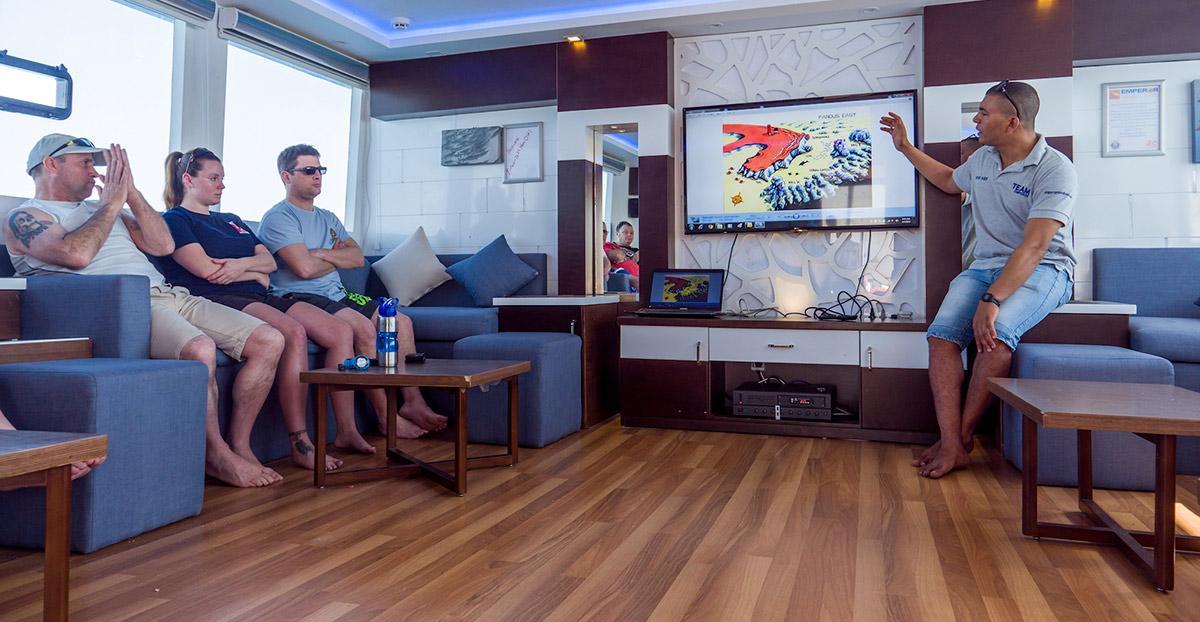
If you have read this far, then your English is good. And English is the international language, so you can expect to hear and use it on liveaboards all around the world. But hey, there will also be other languages used, especially the local language. If you need a member of staff to speak your language then please let us know when you first enquire or book your liveaboard cruise. We can’t always guarantee to provide this, but usually it’s possible. Divemaster Guides & Instructors come from & work all over the world, and many are fluent in more than one language.
All main European languages are well represented in the diving industry in Asia, Africa and Central America. Dive & boat briefings to large groups are usually in English, but if the majority of guests are native speakers of another language, then that’s often used. And underwater we all use the same language anyway!
10 Liveaboard Food
Scuba diving is hungry work, and food is the fuel you need to enjoy it properly. In general, all of our guests on the boats love the food served on board. Fresh food is vital in the hospitality business, especially for hungry divers. There’s always plenty of food to enjoy on scuba diving liveaboard trips, but how good is it and what’s on offer?

You can expect to be very well fed on your next diving adventure if you go on a liveaboard safari! On full days (when you wake up and go to bed on the boat) you can expect to eat up to five times a day! But even on your first and final days on board you will still enjoy lots of fresh, healthy & tasty meals!
The typical meals on a full day aboard are as follows, but can vary from boat to boat.
- Light breakfast is available for self service from 6.00am and should be enough to get you through your early-morning dive. This is usually cereals, muesli, fruit, yoghurts, & toast with butter, jam etc.
- Main breakfast is served almost immediately after the first dive of the day. Here you can expect eggs (fried, omelette etc.), bacon, salad, yogurt, fruits, and maybe hash browns. Now you have plenty of energy for your second dive of the day.
- Lunch is served after the second dive, and is often a blend of local & western dishes that aren’t usually too spicy.
- Snacks & fruits are usually on offer at all times, but extra, nicer versions of fruit are often available between the third & fourth dives.
- A large evening meal is normally after the final dive of the day, but sometimes before a night dive. After a day’s diving you will be treated to a different meal / menu each evening of the cruise, and this will set you up for a good night’s sleep, ready to do it all again tomorrow!
As we mentioned, there’s always some fruits and snacks available throughout the day & night. Plus tea, coffee & drinking water are always available. It’s important to stay hydrated during your liveaboard cruise, so many boats have sachets of rehydration salts available for free or a very low price. Scuba diving & spending time out in the sun both contribute to dehydration, so drink plenty of water.
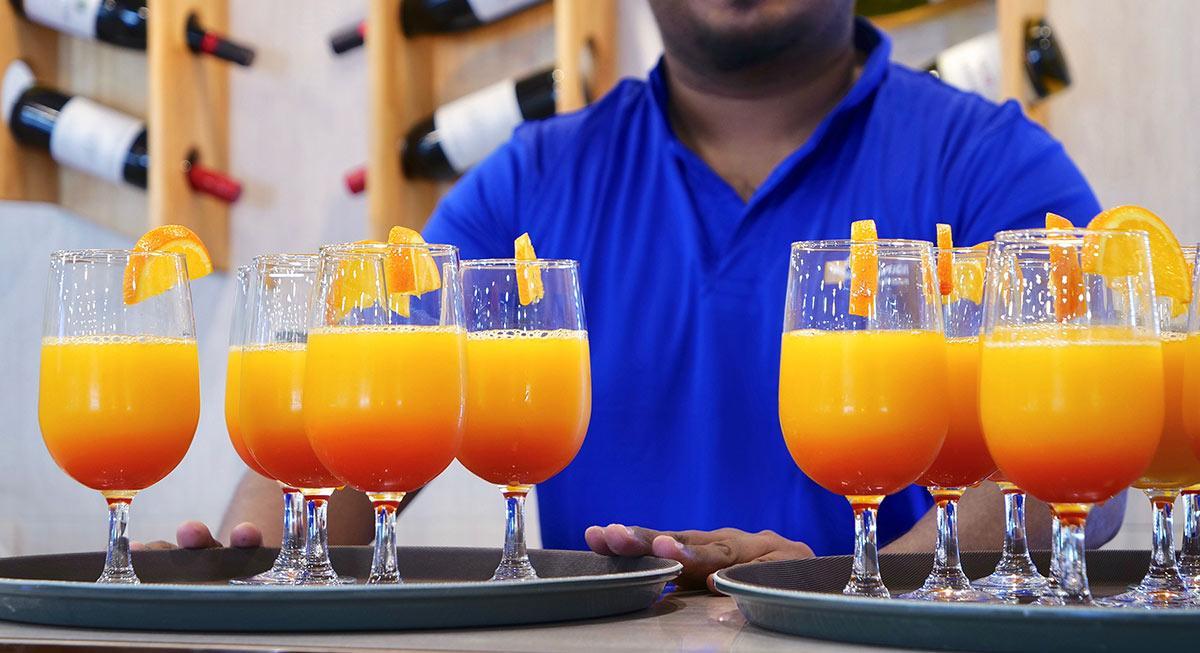
Alcohol is very popular on liveaboard dive cruises, especially cold beer! Almost all boats offer a selection of beers and sometimes wines & spirits. Prices are usually very reasonable.
- It’s not safe to drink alcohol and dive again the same day. Most boats will not allow any guests to dive again on any day that they consume alcohol, even one small beer. Please only drink after the final dive of the day, and never drink too much.
- Alcohol also contributes towards dehydration, and you should drink plenty of fresh water even if you’re full of beer.
Some liveaboard boats have the choice of indoor & outdoor dining areas, whereas others have one or the other. There’s always space for everyone to eat at the same time, but don’t expect lots of room at the table. The communal areas of the boats are better explained in section 7.
Unless you have special dietary needs which are very different from everyone else on board, food is generally served buffet style. But don’t worry if you have any special needs for religious, personal or health reasons. Nearly every boat’s kitchen team can adapt to common dietary needs without much warning. Feeding vegetarians is never a problem. Vegans, and those with food allergies or religious restrictions should always let us or the team know well in advance. Nearly every trip has at least one vegetarian, and at least 30% of our guests have some kind of special request, or would like to let the team know what kinds of food they can’t or don’t like to eat. But please remember that kitchens on boats are never large, and there’s very rarely an opportunity for the team to buy or get extra or special food items out at sea after departure.
In our next section you can learn about liveaboard diving equipment, including how it’s handled during the trip and special things like Nitrox & rebreathers.
11 Diving Equipment on Liveaboard Safaris

This section is about the dive gear on scuba liveaboards. It doesn’t go into too much detail about the gear itself. This section is more about the logistics of trying on rental gear before the trip departs, how gear is stored & cleaned during a trip, and what items are expected or mandatory on diving liveaboards around the world.
In most cases liveaboard departure times are not fixed, and guests are not rushed onto a boat waiting to set sail. You usually have a window of several hours to arrive on board, and in some cases the boat doesn’t actually leave the harbour until the following morning. Therefore, guests who are renting gear have time to try each item on. And if you’re bringing your own dive equipment, you can make sure it made the journey undamaged & check everything works. If replacements are required, there’s usually time to take care of this before the liveaboard leaves the harbour. And anyway, each boat keeps as many spares as possible for during the trip.
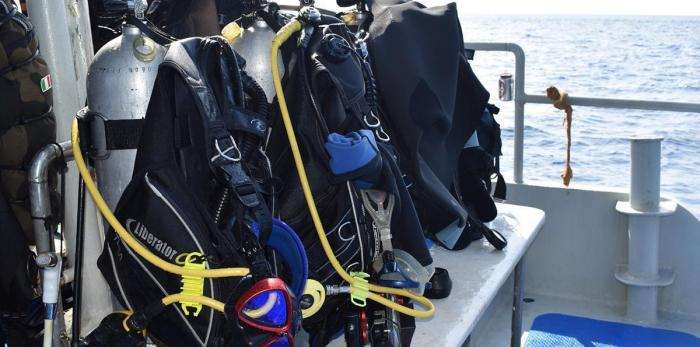
During the trip each diver normally has a ‘tank slot’ which is a place where their gear stays between dives. The BCD & regs stay attached to the tank, which can be filled without having to remove the BCD. Usually there’s a box under the tank slot where you keep your fins & weightbelt. Wetsuits are hung up to dry in a sensible place. Dive cameras, GoPros, and dive computers get their own fresh-water rinse tanks. Masks are often clipped onto your BCD, but everyone has their own preference.
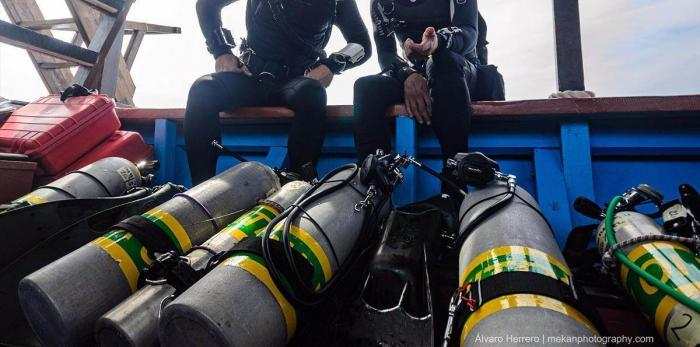
Nitrox enriched air is becoming more & more popular even with inexperienced recreational scuba divers. The increased oxygen content has many benefits, including shortening recovery times & surface intervals, and limiting your chances of decompression sickness. Nearly all of our scuba diving liveaboards offer unlimited Nitrox during your trip. Some do so for free and others make a small charge. It’s always good to let us or the team know in advance if you want to dive with Nitrox.
Rebreather diving on liveaboard trips is not as common as Nitrox, with probably less than 25% of the boats offering rebreather facilities. It’s important to check all the details in advance if you want to join a rebreather-friendly liveaboard diving safari.
Likewise for tech diving on a liveaboard. Most are geared up for recreational scuba diving in guided groups. If you’re a tech diver, or a pair or group of tech divers and you want to join a liveaboard in a country that allows tech diving, then it’s vital to check each boat’s policies and options in advance.
At the end of the trip dive gear needs to be cleaned & dried. If you use rental gear, then the team will do this for you. But if you bring your own, it needs time to dry before being packed for your flight. Depending on the itinerary and the weather, you have plenty of time to get your gear washed & dried while the boat sails back to the harbour. Even if there’s limited sailing time and rain, this process nearly always works without any problems.
Each liveaboard operator has its own policy about which items of gear are compulsory on the trip. In addition to what’s necessary to dive, it makes sense to use a dive computer because you’re doing multiple dives and you never know if you will change buddy groups or dive guide. And because of this, some liveaboard operators say that each diver has to dive with a computer.
Some liveaboards won’t let guests dive without a guide, and insist that every guest ends each dive with their guide. But operators which are more flexible about unguided diving insist on every guest diving with an SMB (Surface Marker Buoy) also known as a safety sausage. If you’re diving without a guide, then an SMB is vital.
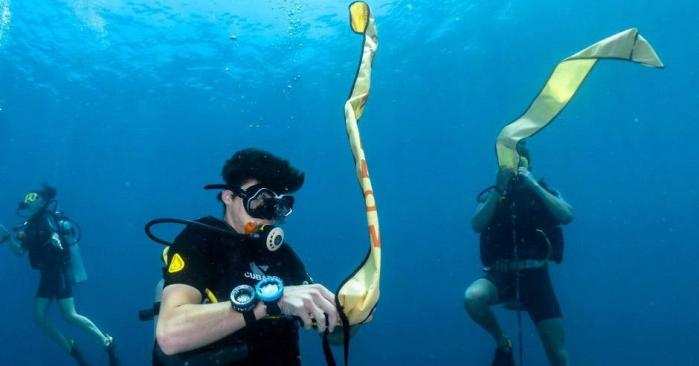
And in diving destinations where currents can be strong or unpredictable and dive sites far from land, some liveaboards supply everyone with a GPS location device, such as the ENOS system.
12 Extra Costs & Local Regulations
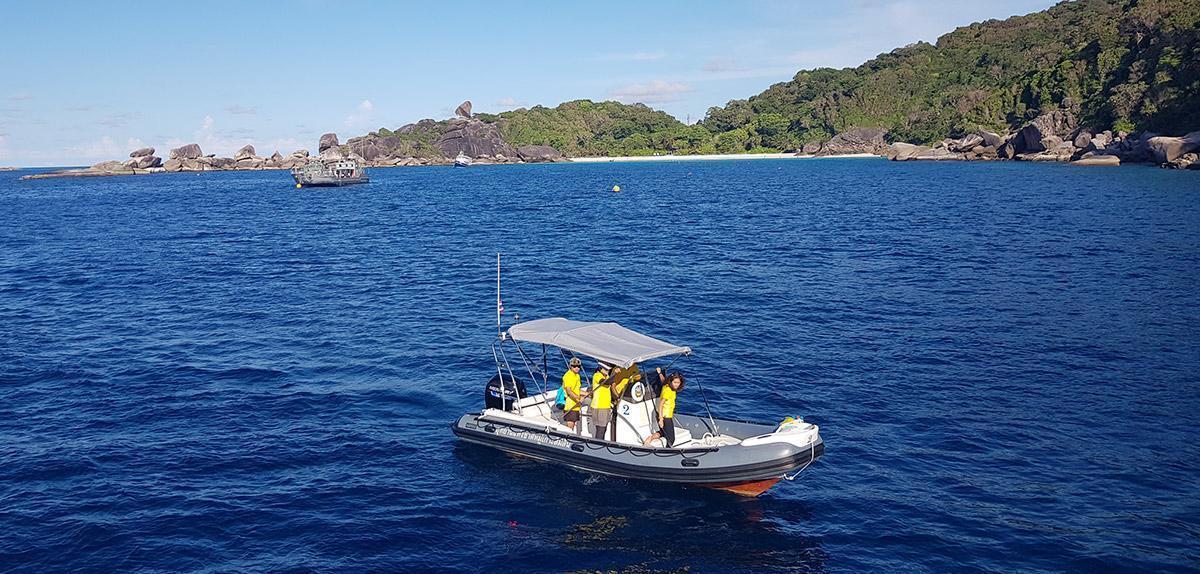
In this section we discuss things that you can’t do or have to do during your liveaboard cruise. Plus any extra things that you will need to pay for while on board. Each dive destination has its own local laws, and each boat has its own policies. Here we just explain in general what you should expect on a cruise anywhere in the world.
Extra Costs
Marine Park & Harbour Fees
Nearly every diving destination worth visiting is protected by the local authorities. This is usually local rangers who make sure that there are no fishing boats, or to limit the number or activities of visitors. National (Marine) Park Fees are a tax paid by you to support the cost of this protection. It’s not fair to expect rangers to work for free, and in most cases they use boats to patrol the area, and this costs money.
Harbour fees don’t apply to all countries, but in places like Indonesia & Egypt it’s common to pay a harbour fee. This is a contribution to what the boat has to pay to moor in the harbour, often overnight.
In most cases, marine park & harbour fees are payable on board when you arrive, and nearly always in cash.
We have already discussed diving equipment in Section 10. This is just a little reminder that if you’re using any items of dive gear supplied by the boat, then you normally pay for this on board. Prices depend on if you rent a whole set or just individual items. Costs vary greatly from $10/day to up to $30 or more for a standard set of gear. Things like dive computers, night diving torches, long wetsuits and SMBs usually have an extra cost.
Paying a tip
Paying a tip to your dive guide or the crew is always appreciated, and in many cases it is expected. But it’s never mandatory, otherwise it would be called a Service Charge. In our opinion, tips are a nice way to say an extra thank you for service above & beyond your expectations. But it’s important to remember that some cultures don’t normally tip or expect tips. And in other cultures it’s standard practice to pay a substantial tip. We advise to prepare to leave a tip, but decide on how much (if any) at the end of your cruise.
Alcohol
Alcohol is nearly always available on liveaboard diving cruises. It’s important never to dive on the same day after drinking even one small beer. But it’s very common for divers to enjoy a few drinks at the end of the diving day. A few of our liveaboards will offer a glass of wine at dinner or a beer for free, but in most cases you have to pay for all the alcoholic drinks that you consume during your cruise. Usually guests take beers from the fridge and write this down on an ‘honestly list’ which is calculated and paid for at the end.
Country-Specific Regulations
Some countries and/or national parks have regulations about activities allowed. These may include diving depths, diving at night, insurance, use of dive computers, sailing at night, and fishing.
Maximum depths
Recreational divers don’t normally descend deeper than 30 metres (99ft.) which is fine for most people. Many of us are certified to 40 metres, or have dipped below 30m. Plus technical diving is becoming very popular. Countries like The Maldives set a limit of 30 metres for all divers, regardless of whether or not you’re certified deeper than that. Most other countries don’t have national depth limits, but each boat operator or marine park might set a maximum limit. This is always done for reasons of safety first, followed by practicality & logistics.
Night diving is forbidden
Night diving is forbidden in the national marine parks of The Red Sea in Egypt. So itineraries that go into the marine parks will give you three day dives spread out, or four with less time to relax in between. Many top dive sites all around the world are not suitable for night diving, but there are no official rules.
Diving insurance
Many countries’ regulations insist that all divers have a valid insurance policy to cover transport to & treatment in a decompression chamber. Diving insurance is excellent value, and even if not mandatory you should get cover. And it’s the same for dive computers. Even if you’re not forced to wear one, it’s a really good idea. You might claim that you don’t really understand how to use it, but it’s still a vital piece of kit to make sure you dive safely.
Boat stays in the harbour during the night
Our liveaboard guests in Egypt might be surprised that when everyone’s on board, the boat stays in the harbour during the night. This is better for you to get the most-comfortable night’s sleep, but also safer if the boat sails during the day and not at night. The Red Sea has enough shipwrecks, and we don’t need or want any more.
Fishing in diving areas
Fishing in diving areas is a much-debated topic. Some divers hate all kinds of fishing, but many of them are happy to eat fish. Others like diving and fishing! Each area has its own regulations about where fishing is allowed.
But imagine you’re diving and you come across active fishing lines or fishing nets. It wouldn’t be much fun, would it? So it’s not really fair if you’re allowed to fish in the same area where there might be divers below. And every fish that’s caught is one fish less for divers to see & enjoy swimming around the reef.
13 Booking, Payment & Cancellation Terms
When you book a scuba diving liveaboard cruise, there are several ways to pay, and a range of booking & cancellation terms.
Ways to pay for your trip
Online credit card payments: Until recently, the only way to make an instant and secure payment online was by using a credit card. For the customer, this went through their card issuer, for example VISA, MasterCard, American Express etc. For the vendor, a payment gateway is required, and PayPal is still the biggest name in the world.
Advantages to you include the security of being able to make a claim against unscrupulous traders who don’t provide the goods or services they promise. This peace of mind means a lot to many people. Also, using a credit card enables you to actually pay from your own money at later date. This is ideal if you don’t have the money in your bank to make the payment right now, or if you want to take advantage of a short-term interest-free loan.
But be aware of the exchange rates that the large banks charge. People normally like to see the amount in their own currency, and most card companies & payment gateways offer this by default. But by showing you in your own currency, they have sneakily used their own exchange rate. Some cards & banks also add a ‘foreign transaction fee.’
But in addition to credit card payments, there are now many ways to make fast & secure transfers without having to follow the restrictive conditions of the large banks, card providers, and payment gateways.
New ways to send money overseas include regular banks offering online or in-branch transfers that are almost instant and incur very small or no fees. Also, there are several very popular companies which make it easier, cheaper and quicker. PayPal is currently the world leader, but TransferWise, Azimo & Western Union are popular too. You can use your credit card, funds in your bank account, or even cash to get the money to people & businesses in countries all around the world. And some businesses have a ‘borderless bank account’ where you can make a domestic transfer from your bank to an account in your country. This is nearly always free, and the official exchange rate of the day is used.
The main advantage of TransferWise & Azimo is that they offer the lowest costs, including any fees & the exchange rate. You might think that paying on your card is cheapest, but it’s often not the case. Plus TransferWise & Azimo make it really easy and confidence inspiring.
Be aware of the fees in PayPal & Western Union, though. They can look attractive with clever marketing, but the bottom line nearly always shows that you have been charged in a fee or exchange rate favourable to them.
We are in the extremely-fortunate position of having PayPal accounts in Europe and Asia, plus we have a borderless bank account with branches in many countries. This makes it really easy & free for our guests to pay us for scuba diving liveaboard trips, ensuring the best & fairest exchange rates & no banking fees. Keep reading to learn about how much you need to pay to book a trip, and your options if you need to cancel or postpone.
How much you pay & when depends on lots of factors
Each boat or operator has its own booking terms. This applies to how much you pay and when, and what happens if you have to cancel. Unlike when booking flights, you normally just pay a deposit to confirm your dive trip, and then pay the balance at a later date.
Deposits vary from 10%-35% of the trip price. Before Covid-19 destroyed tourism around the world, it was normal for you to pay on average 20-30% deposit to confirm your booking. Usually the deposit is forfeited if you cancel, but sometimes it can be refunded or used for a trip with the same operator on a different date.
Balance payments are due before a set deadline. This varies depending on the operator. Some want the balance of the trip paid 90 days before departure, but 30 or 60 days is most common. And some Thailand liveaboards even let you pay the balance when you arrive!
Please note that some online liveaboard booking agencies ask for full payment to confirm your booking, even if the liveaboard operator normally asks for a deposit first then the balance later. So, why would the online agent ask for full payment at the start? They do this because it’s easier & better for them, but of course it’s not as good for you. We follow the booking terms for each boat, which is nearly always better for you when compared to other online liveaboard agencies.
Booking during Covid-19 restrictions : The booking terms that are explained above refer to normal circumstances. But during this Covid-19 period, when no one is sure about travel restrictions, most bookings require just 10% deposit to confirm, and this is often refundable. Then the 90% balance is due 30 days before your trip. And if you have to cancel for Covid-19 reasons in those final 30 days, some liveaboards allow you to postpone your trip instead of forfeit what you’ve paid. Also in most cases (Covid & normal), if you know of anyone who would be able to take your place, it’s usually ok to just change the name on your booking at no cost if you can’t go.
Once Covid-19 is under control and things return to normal, we expect the original booking terms to be applied.
14 Visiting Islands & Beaches
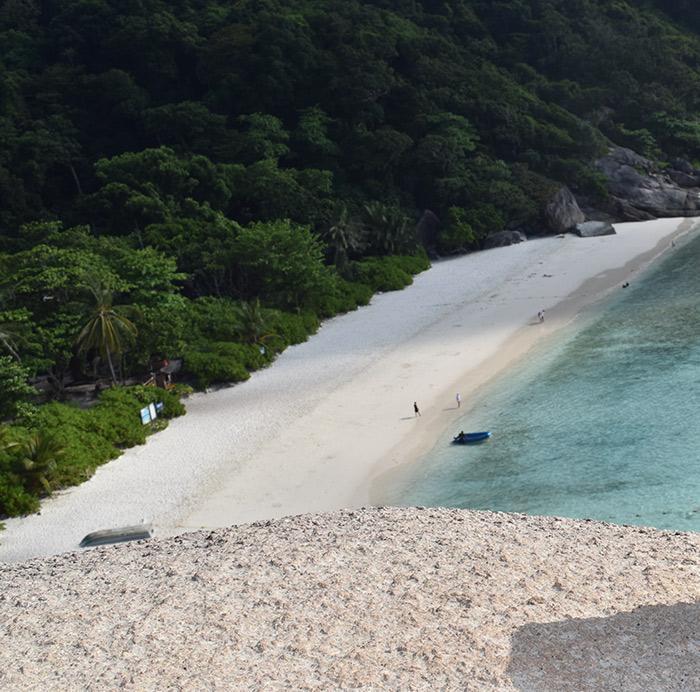
When & where possible, the liveaboard teams try their best to get everyone on an island or beach during the cruise. For example, at The Komodo Islands in Indonesia nearly every liveaboard safari includes a half-day excursion to visit the Komodo Dragons. Also in Indonesia, trips around Raja Ampat, Ambon and Sulawesi nearly always include a beach visit. Some even have a trip to a freshwater lake full of jellyfish!
Most Maldives diving liveaboards try to include a romantic evening dinner on an uninhabited island. The team usually go ashore while you’re diving and prepare everything. And if conditions allow, they make a huge Whale Shark or other species out of the sand!
Part of a scuba diving liveaboard adventure usually involves visiting a tropical island to explore the white sandy beaches. Most of our trips offer this, but a few things are important to consider.
- The logistics of getting a group of guests from the main boat to beach usually mean using the boat’s tender dinghy or dinghies to ferry guests back and forth. The large boats can’t get too near beaches or islands due to the risk of them damaging the reef or getting stuck.
- You also have to consider the time it takes. Between dives you usually have a couple of hours, but most people need to eat, and many like a shower and maybe a nap. The best time is late afternoon or early evening on a day when no night dive is scheduled.
- Local authorities’ regulations might not allow you on some islands. For example, Koh Tachai in Thailand’s Similan Islands was recently closed to the public. Islands or beaches might be closed to everyone, or it might be that liveaboards aren’t allowed within certain zones.
- The locations of dive sites and the beach or island need to be near each other. In an ideal world there are two decent dive sites nearby, meaning you can visit the island and not have to repeat a dive site. Sometimes, there’s great diving to be had in one location, but no beaches nearby. Don’t forget that you join the trip to go diving. If the itinerary has to suffer just for some people to get sand between their toes and take some selfies, then it’s important to find out what the majority of guests want to do.
But if you & your friends make up the majority of guests, or maybe the whole group, then it’s a lot easier to persuade the tour leader. And on the subject of taking over a whole boat for just your group, that’s what our next section is about. Read on to find out about booking the whole boat for a dream liveaboard private cruise!
15 Full Charter Bookings
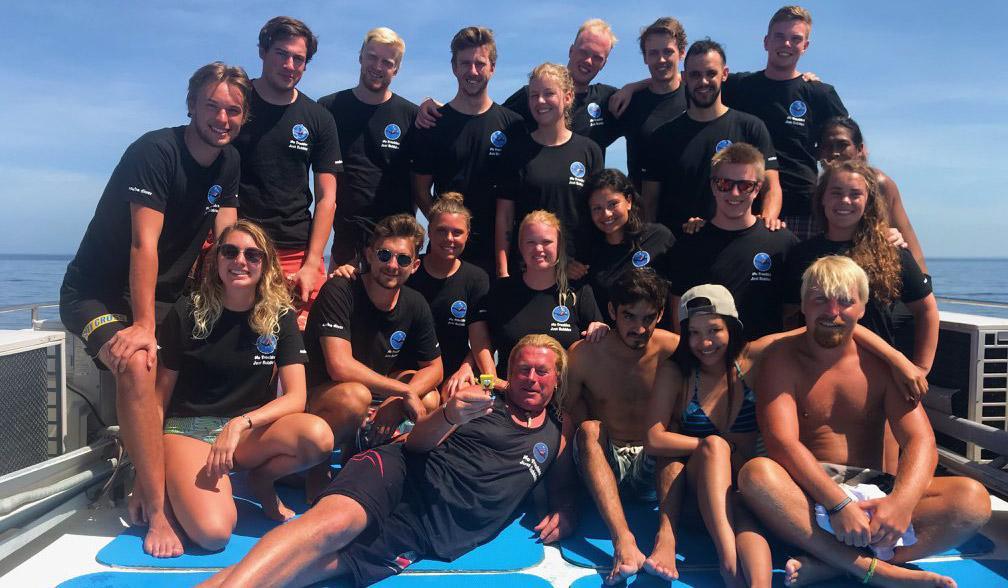
Having a whole boat to yourselves is referred to as a ‘full charter.’ If you are in a dive club or have large family or plenty of diver friends, you would be surprised how good value it is to book a full charter scuba diving liveaboard cruise. Full charters give you the privacy of not having other guests on board who you have never met before. Also, there’s nearly always more flexibility about many aspects of the trip, such as the dive destinations, itinerary, food, activities, and more.
‘But our group size isn’t big enough to fill the boat.’ : You would be surprised how many people have the same worry when they plan to book a whole liveaboard as a full charter. But in nearly all cases, when their friends find out about it, all of a sudden they can easily fill the trip, and even have to turn people away!
Full charter rates are usually not much different to just booking all the cabin spaces of a scheduled trip. But sometimes it is a lot cheaper, so don’t be shy to ask! Price variations all depend on which boat, the boat’s guest capacity, the time of year and the planned itinerary.
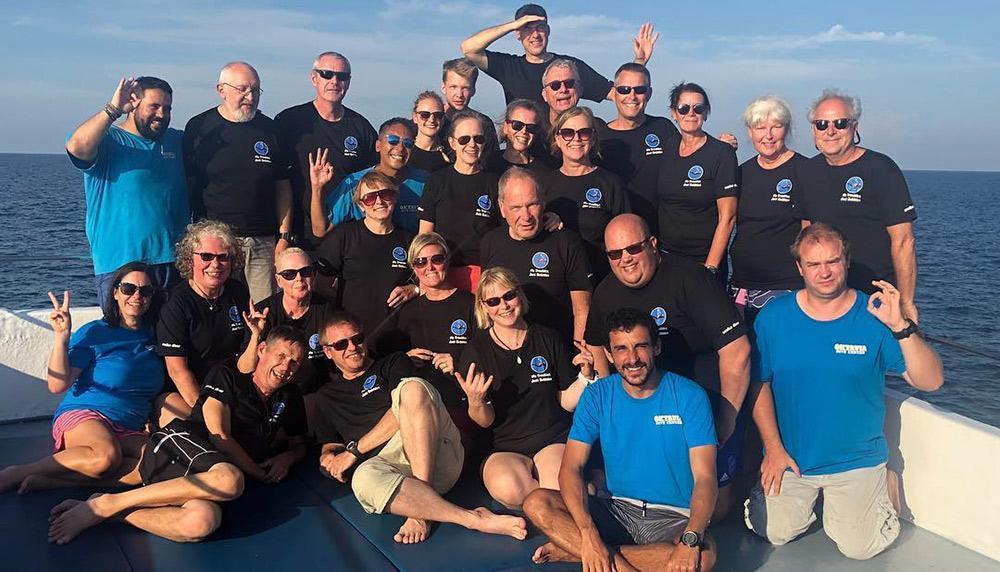
What’s included?
Just like a scheduled trip that’s open to the public, you get use of tanks & weights, full-board accommodation with food, drinking water, tea, coffee, and local land transfers all included in the rates. Some of the full charter liveaboard bookings include the crew & a full complement of dive staff, whereas others just provide the crew and one Western trip leader. Fewer dive staff allows for your group to organise buddy pairs yourselves and have more freedom underwater. But having the dive guides to lead diver groups gives you the added benefit of dive site navigation & not missing out on spotting specific local species.
Booking terms for full charters differ a little bit from just joining a standard trip. This is normally because full charters are often booked a year or more in advance. Each boat has its own booking policy, but in general you should expect to pay a small deposit at first. Then six or nine months before the trip, a second (larger) deposit is required. And the final payment is usually three months before departure. Of course, you’re thinking “But what about cancelling or changing the dates?” Again, this varies from boat to boat, and the later you ask to cancel or change, the less time the boat has to resell the trip to the public. Therefore, any fees are higher as departure date approaches. But we all love full charter bookings, and nobody wants to cancel or charge unnecessary fees. Changing dates or maybe opening up some cabins to be sold to the public is a much better alternative. Anyway, each boat has its own policy, so please get in touch to find out more.
In summary, if you think that you can gather together enough people to fill up 70% of a liveaboard’s cabins for your chosen dates, then you should definitely look at a full charter. Rates are more reasonable than you might expect, and there’s no beating that feeling you get on your own private cruise!
16 Covid-19

It all depends on when you’re reading this and how the world has managed to deal with Covid-19 so far. There was a time when borders were closed and no international diving tourists were allowed to enter many countries. Now things are starting to open up, with countries including Egypt being the easiest to travel to and dive in. The Maldives is also open as of September 2020, but negative PCR tests are required. Also, at the time of publication, The Maldivian authorities limit guests to no more than one night in a transit hotel before & after the diving safari. But as we explain in our itineraries section, Maldives liveaboard itineraries are designed to enable you to fly in, board the boat, dive for a week, then disembark and go straight to the airport. Things are changing daily and by the time you read this things will have changed again.
The situation and regulations regarding quarantine upon arrival in the dive destination, and when you return home, is also changing day by day. Of course, it’s not at all practical to be expected to enter a long quarantine period before diving when you arrive. But although inconvenient, it’s much more possible for you to self-isolate at home after your trip.
Social distancing on boats is not easy, but each operator does what they can. Even if guests stay in cabins alone and eat far away from others, they’ll be right next to each other on the dive deck or in a support dinghy. If there’s any current, staggering groups and pickups isn’t safe or practical. So basically, social distancing while on the boats isn’t really something that can work effectively.
Holiday insurance is always recommended, and one that covers a disrupted trip due to Covid-19 makes even more sense. Getting cover for your medical expenses if you contract Covid-19 while on holiday would be the maximum insurance. But it’s worth looking into a policy that covers your trip suffering from local regulations being introduced or your liveaboard itinerary having to change out of the operator’s control.
17 Summary
Thanks for getting all the way down this long page. We hope that this blog has helped you in some way. We also really hope that by the time you read this Covid-19 will not be affecting our lives as much, and leisure travel will be back to normal. We love helping people to find the best trip to suit their needs, and our small team are helpful & experienced. So, now that you have answers to most general questions, why not get in touch to ask us about any other details which are important to you?
